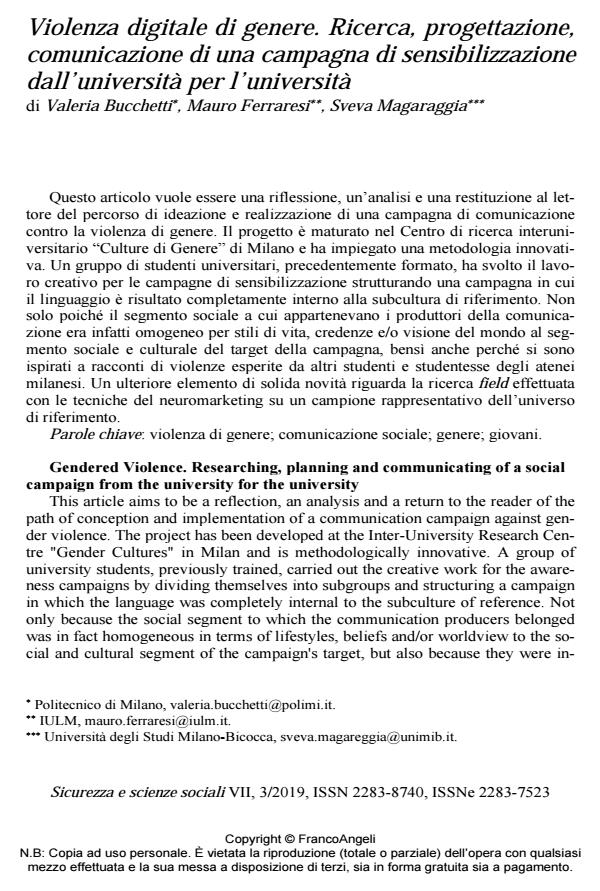Gendered Violence. Researching, planning and communicating of a social campaign from the university for the university
Journal title SICUREZZA E SCIENZE SOCIALI
Author/s Valeria Bucchetti, Mauro Ferraresi, Sveva Magaraggia
Publishing Year 2020 Issue 2019/3
Language Italian Pages 14 P. 138-151 File size 208 KB
DOI 10.3280/SISS2019-003010
DOI is like a bar code for intellectual property: to have more infomation
click here
Below, you can see the article first page
If you want to buy this article in PDF format, you can do it, following the instructions to buy download credits

FrancoAngeli is member of Publishers International Linking Association, Inc (PILA), a not-for-profit association which run the CrossRef service enabling links to and from online scholarly content.
This article aims to be a reflection, an analysis and a return to the reader of the path of conception and implementation of a communication campaign against gender violence. The project has been developed at the Inter-University Research Centre "Gender Cultures" in Milan and is methodologically innovative. A group of university students, previously trained, carried out the creative work for the aware-ness campaigns by dividing themselves into subgroups and structuring a campaign in which the language was completely internal to the subculture of reference. Not only because the social segment to which the communication producers belonged was in fact homogeneous in terms of lifestyles, beliefs and/or worldview to the so-cial and cultural segment of the campaign's target, but also because they were in-spired by tales of violence experienced by other students at the Milanese universi-ties. Another element of solid novelty concerns the field research carried out with neuromarketing techniques on a representative sample of the reference universe.
Keywords: Gender based violence; social campaigns; gender; youth
- L’effet-Sanremo. Dénoncer le viol, normaliser le sexisme Carlo Andrea Tassinari, in Actes Sémiotiques /2021
DOI: 10.25965/as.7316 - Transdisciplinarity among universities as a catalyst for a gender-sensitive revolution. Strategies and approaches from the perspective of communication design Francesca Casnati, Valeria Bucchetti, in Feminismo/s /2024 pp.151
DOI: 10.14198/fem.2024.43.07 - HCI International 2020 – Late Breaking Papers: Interaction, Knowledge and Social Media Mauro Ferraresi, pp.265 (ISBN:978-3-030-60151-5)
- Gender Perspectives for a Renewed Design Culture Valeria Bucchetti, pp.3 (ISBN:978-3-031-88553-2)
Valeria Bucchetti, Mauro Ferraresi, Sveva Magaraggia, Violenza digitale di genere. Ricerca, progettazione, comunicazione di una campagna di sensibilizzazione dall’università per l’università in "SICUREZZA E SCIENZE SOCIALI" 3/2019, pp 138-151, DOI: 10.3280/SISS2019-003010